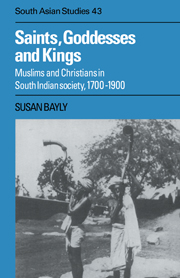Book contents
- Frontmatter
- Contents
- List of plates
- List of maps
- Preface
- Note on transliteration
- List of abbreviations
- Introduction
- Part I
- 1 South Indian religion and society
- 2 The development of Muslim society in Tamilnad
- 3 The Muslim religious tradition in south India
- 4 The south Indian state and the creation of Muslim community
- 5 Warrior martyr pirs in the eighteenth century
- 6 The final period of nawabi rule in the Carnatic
- Part II
- Select glossary
- Bibliography
- Index
- CAMBRIDGE SOUTH ASIAN STUDIES
- Plate section
4 - The south Indian state and the creation of Muslim community
from Part I
Published online by Cambridge University Press: 04 December 2009
- Frontmatter
- Contents
- List of plates
- List of maps
- Preface
- Note on transliteration
- List of abbreviations
- Introduction
- Part I
- 1 South Indian religion and society
- 2 The development of Muslim society in Tamilnad
- 3 The Muslim religious tradition in south India
- 4 The south Indian state and the creation of Muslim community
- 5 Warrior martyr pirs in the eighteenth century
- 6 The final period of nawabi rule in the Carnatic
- Part II
- Select glossary
- Bibliography
- Index
- CAMBRIDGE SOUTH ASIAN STUDIES
- Plate section
Summary
Nawabi rule in Tamilnad
Having looked at the traditions of south Indian Muslim worship which came into being by the beginning of the eighteenth-century, chapters 4 and 5 will show how the various linguistic and status groups who shared in this tradition began to be reshaped into a more formally defined community of Muslim believers. Although the south was never fully ‘Islamised’, the creation of this limited sense of community was largely due to the rise of the region's first Muslim-ruled state, the nawabi of Arcot (also known as the Carnatic) with its two successive lines of would be dynasts.
It will be remembered that the first of these two lines of nawabs belonged to an élite population of Dakhni trading and service people, the Navaiyats. The most powerful members of this group were those who had held high posts under the sultans of Bijapur and the other Deccani Muslim states. When these domains came under Mughal rule at the end of the seventeenth century, many leading Dakhnis were able to seek preferment within the imperial service system. For most of these gentry families the crucial opening came at the beginning of the eighteenth century when the whole of the Tamil country (the Payanghat or ‘Lower Carnatic’, that is the region ‘below the Ghats’ from Nellore to Kanniyakumari) was declared a subah or province of the Mughal empire. In theory the new subah was subject to the adjacent Mughal province of Hyderabad which had been annexed after the conquest of Golkonda in the 1680s. Here, too, a line of imperial office-holders, the Nizams of Hyderabad, had begun to carve out an independent dynastic base.
- Type
- Chapter
- Information
- Saints, Goddesses and KingsMuslims and Christians in South Indian Society, 1700–1900, pp. 151 - 186Publisher: Cambridge University PressPrint publication year: 1990

